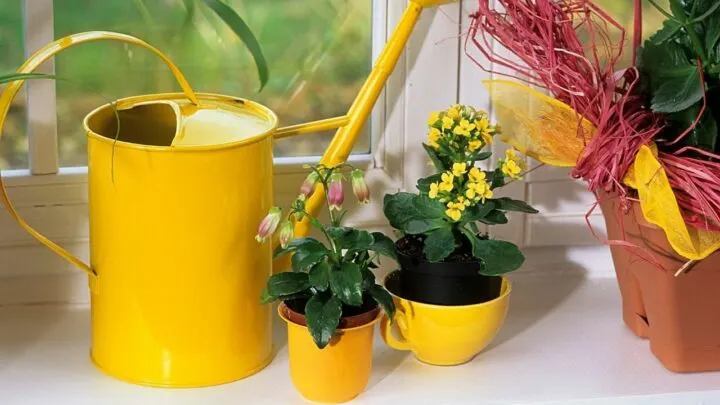If you grow the right plants and take precautions to shield them against direct sunlight, southwest-facing windows are indeed a good area to grow indoor houseplants.
South-facing and west-facing window directions receive a lot of direct sunlight according to the University of Iowa. The southwest-facing window is no different in this regard.
Plants that prefer southwest-facing windows benefit from the intense natural light that comes with southern exposures.
However, keep in mind that the window’s material may also increase the temperature near the plant.
I, therefore, compiled a list of plants suited for southwest-facing windows that enjoy the bright light and warmth coming from this window direction.
15 Plants for Southwest Facing Window
- Kalanchoe
- Pencil Cactus
- Citrus Trees
- Chinese Money Plant
- Ficus Audrey
- Aloe Vera
- Ponytail Palm
- Fiddle Leaf Fig
- Lavender Plant
- String of Hearts
- Anthurium
- Areca Palm
- Bird of Paradise
- Dracaena Fragrans
- Jade Plant

15 Plants for Southwest Facing Window
Table of Contents
Best Plants for Southwest Facing Window
1. Kalanchoe
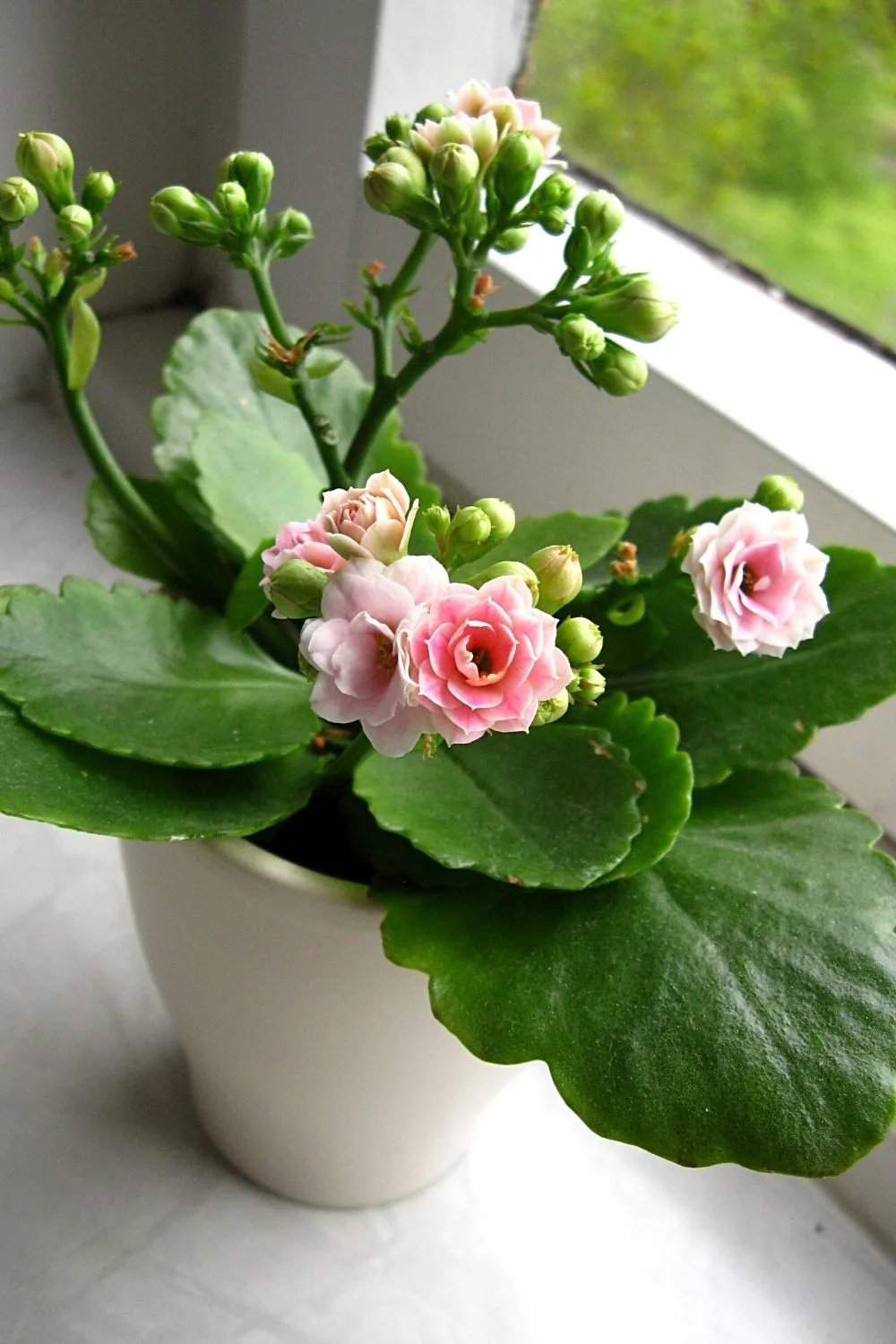
Kalanchoe is a succulent blooming plant that thrives well when placed in a southwest-facing window
Kalanchoe is a succulent blooming plant that is indigenous to tropical Africa and Madagascar, although it has now spread well beyond its usual native range.
Surprisingly, this genus was one of the earliest plants to travel into space.
In 1979, it was deployed to the Soviet Salyut spaceship on a test launch. These lovely plants don’t occupy a lot of area, making them ideal for compact flats and living rooms.
The houseplant is usually offered for purchase in the late winter and early spring. A German hybridized named Robert Blossfeld developed the Kalanchoe in 1932.
- Scientific name: Kalanchoe
- Size: 1 to 1.5 feet (0.3-0.5 meters) tall
- Growth rate: These are slow-growing plants
- USDA Zones: Zones 10 through 12
- Soil: Well-aerated, well-draining soil that has 40% of perlite plus 60% peat moss.
- pH: 8 to 6.3
- Water: Let 2 inches of soil feel dry and water every 2-3 weeks
- Light: Bright natural sunlight
- Fertilizer: Occasional feeding with a well-balanced fertilizer
- Temperature: 65 to 85 degrees Fahrenheit (18-29 degrees Celsius)
- Humidity: Average to low
2. Pencil Cactus
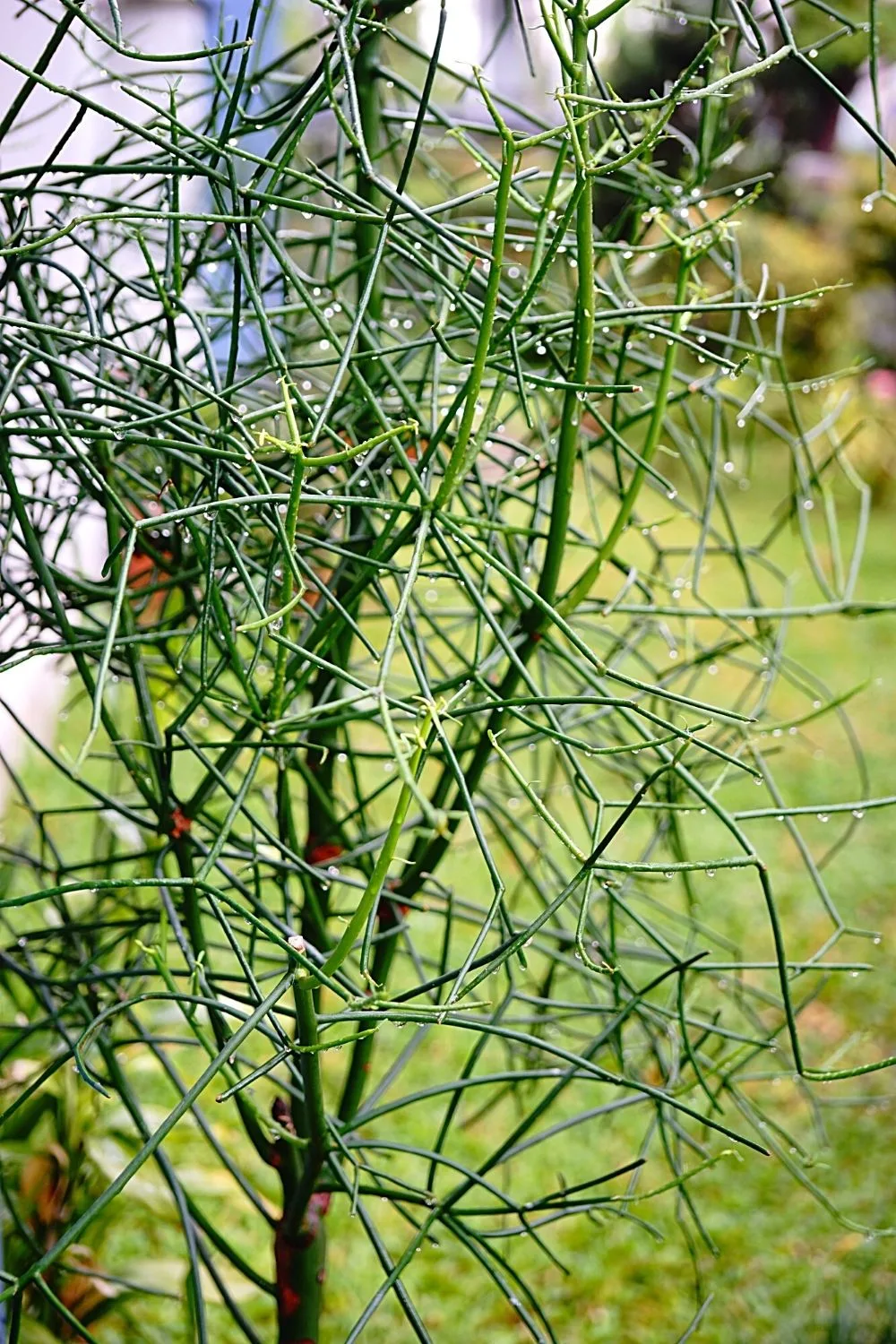
Pencil Cactus is a toxic plant, hence, even if you place it in a southwest-facing window, make sure it is far away from pets and children
It is a succulent species inhabitant of certain regions of Africa. It has slender, greenish stems with a pinkish tinge to them when the plant is young.
Cultivate this plant with caution because it contains a toxic chemical that can cause eye damage if the plant is split.
Do wear gloves and goggles when dealing with this plant. After touching or pruning this cactus, make sure to thoroughly wash your hands.
Maintaining the plant in your potted houseplant collection would be easy if you kept it far from kids and pets, so they do not chew the leaves.
- Scientific name: Euphorbia Tirucalli
- Size: 30 feet (9 meters) tall
- USDA Zones: Zones 11 through 12
- Growth rate: Fast-growing
- Soil: Well-draining sandy soil
- pH: 5 to 7.5
- Water: 2 to 3 times during summers and no watering during winters
- Light: Bright location with direct sun
- Fertilizer: Balanced liquid fertilizer during the spring season
- Temperature: 65 to 75 degrees Fahrenheit (19 to 23 degrees Celsius)
- Humidity: Moderate levels
3. Citrus Trees

Citrus Trees can be grown indoors, and are best placed in southwest-facing windows
Citrus trees have become increasingly common as a houseplant in recent times.
Who doesn’t want freshly harvested lemons or oranges out of their own home tree?
Citrus trees are innate to tropical and temperate parts of the South Pacific, Australia, and Southern Asia; however, they have spread to every corner of the planet due to modern agriculture.
These woody trees come in a variety of sizes and shapes, from little shrubs to enormous trees, and their fruits are no exception.
Lime, Meyer lemon, Kumquat trees, and Calamondin orange are some of the most popular citrus plants to cultivate indoors.
- Scientific name: Citrus
- Size: 20 feet (6 meters) tall
- USDA Zones: Zones 9 through 11
- Growth rate: Moderate
- Soil: Sandy loam soil that drains well
- pH: 6 to 7
- Water: Water it twice a week
- Light: 12 hours of direct sun
- Fertilizer: Well-balanced citrus plant fertilizer
- Temperature: 65 to 75 degrees Fahrenheit (18-22 degrees Celsius)
- Humidity: About 50%
4. Money Plant
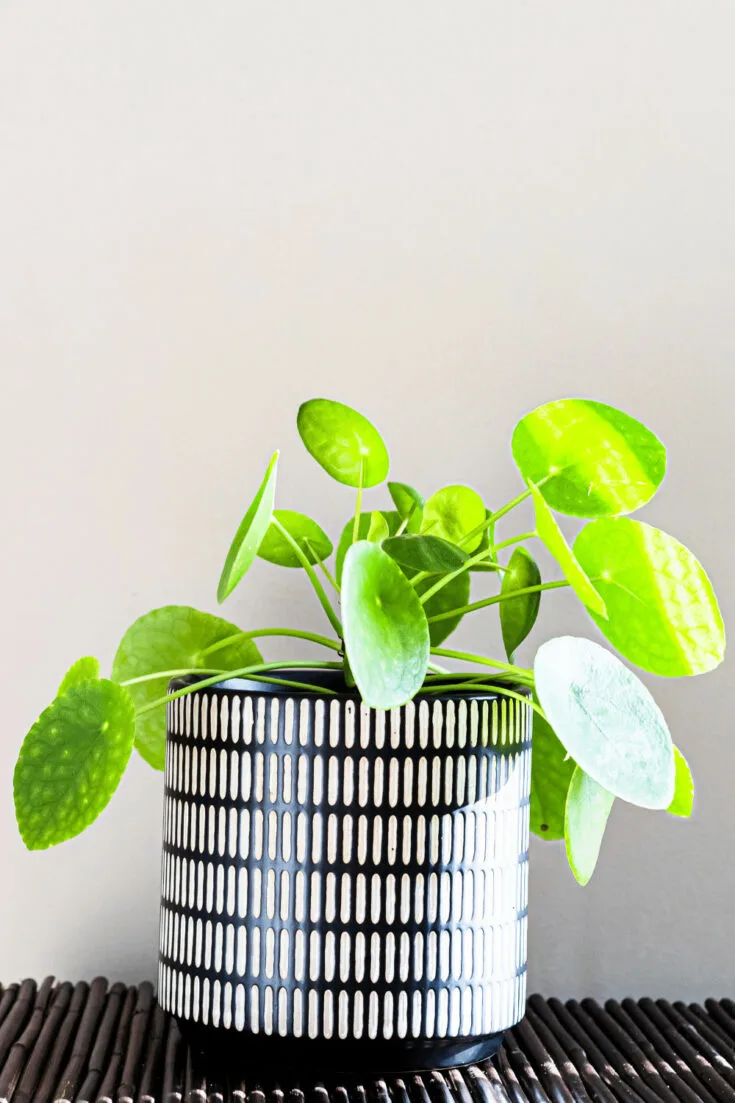
Chinese Money plants (Pilea peperomioides) are well suited for southwest-facing windows
The Money plant (Pilea peperomioides) is a famous perennial plant with spherical, smooth leaves and simple indoor needs.
The plant is endemic to areas of Southern China, and it is frequently given as a luck or gift item and is used in feng shui.
If the plant is left in a cold room, it might produce small white flowers with pink-tinted stems on maturity.
It is a great choice for anyone who is just starting his gardening journey because of the low maintenance requirements of the plant.
- Scientific name: Pilea peperomioides
- Size: Up to 12 inches (20-30cm)
- USDA Zones: Zones 9b through 11b
- Growth rate: Fast grower
- Soil:50% soil, 40% cactus mix, and 10% perlite
- pH: 6 to 7
- Water: Every 7-10 days during summer and once every fortnight (2 weeks) during winter
- Light: Lots of bright indirect sunlight
- Fertilizer: Liquid fertilizer at 1/4 strength in the growing season
- Temperature: 60-86 degrees Fahrenheit (16-30 degrees Celsius)
- Humidity: 40%
5. Ficus Audrey

Despite its height when grown in the wild, simply trim your Ficus Audrey if you plan to place it near your southwest-facing window
Another fig tree that is widely cultivated as a pot plant is Ficus Audrey, sometimes known as the Indian Banyan.
This variety is India’s signature tree and is one of the world’s tallest trees in regard to crown cover.
Ficus Audrey is easier to manage indoors, unlike the similar variety of Fiddle Leaf Figs.
Regardless of its height in the natural habitat, simply trim this tree to keep it under control as a houseplant.
It adapts easily to different environments, is much less fussy about water requirements, and doesn’t demand lots of light.
It is classified as a moderate care houseplant.
With appropriate maintenance, Ficus Audrey can thrive quite quickly, especially in the springtime and summers.
With this beautiful gem, you may add a contemporary, minimalist vibe to your plants garden.
- Scientific name: Ficus Benghalensis
- Size: 5 to 10 feet (1.5-3 meters) tall
- USDA Zones: Zones 10 through 12
- Growth rate: Slow growers
- Soil: Cactus soil with additional perlite that drains well and is well-aerated
- pH: 6 to 6.5
- Water: Consistent, moderate watering during the growth phase while allowing the top 2-3 inches to dry out
- Light: High levels of bright direct light
- Fertilizer: Well-balanced liquid fertilizer
- Temperature: 70-80 degrees Fahrenheit (21-26 degrees Celsius)
- Humidity: Less than 40%
6. Aloe Vera
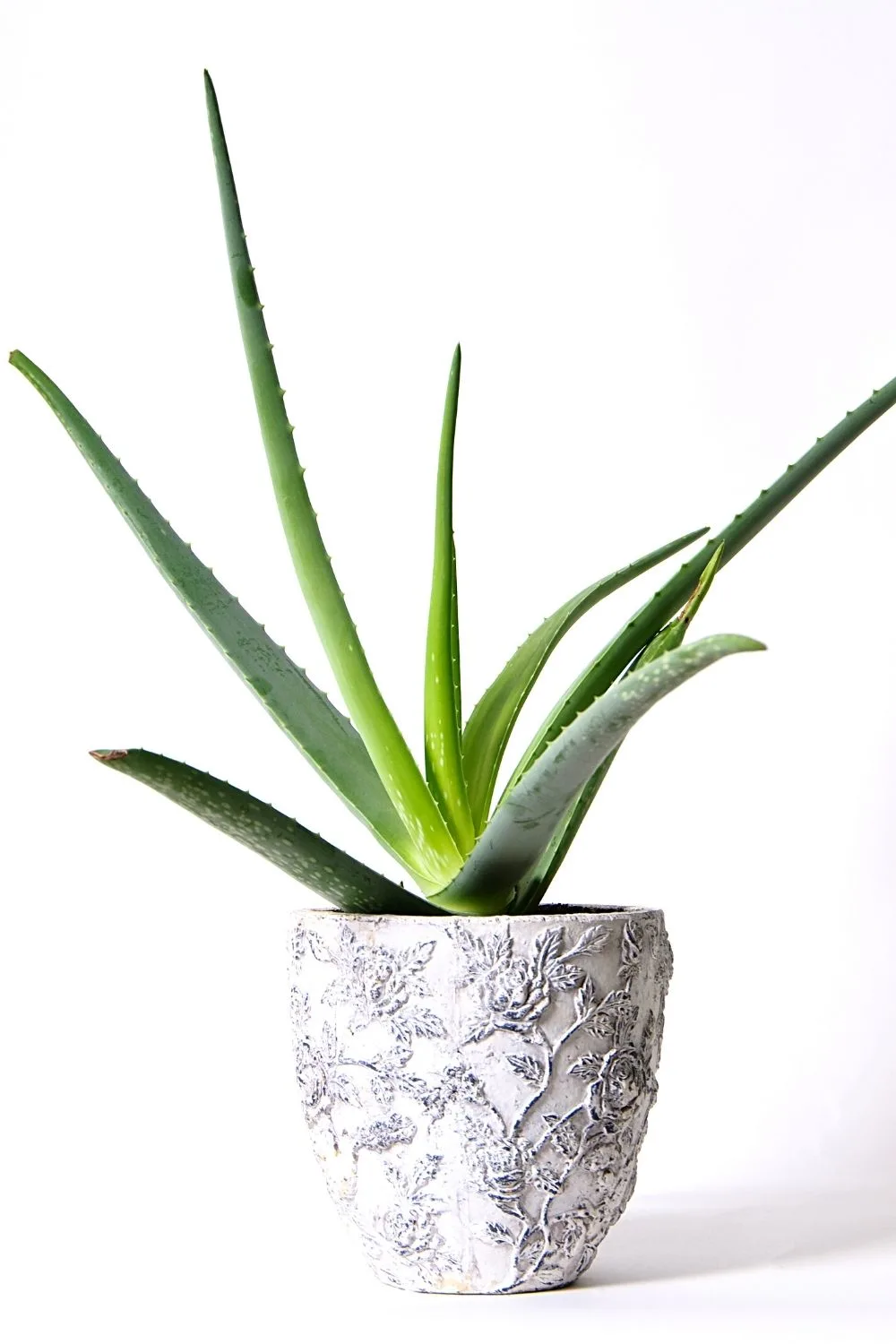
With its many beneficial properties, you can grow your Aloe Vera near your southwest-facing window
Aloe Vera is a fleshy plant that originated in the Arabian Peninsula but now flourishes in tropical, semi-tropical, and dry regions all over the world.
Don’t immediately shift your aloe from the shade to the sun; it requires time to acclimate to the bright light, or it will scorch.
Wait for a week in dappled shade prior to transferring it to a sunnier place.
The therapeutic qualities of this plant are well-known. Its thick leaves contain a gel-like material that is supposed to help heal skin inflammation and wounds.
- Scientific name: Aloe Vera
- Size: 1 to 3 feet (0.3-0.9 meters) tall
- USDA Zones: Zones 8 through 11
- Growth rate: Fast-growing
- Soil: Mix containing bark, perlite, lava rock, or all three
- pH: 7 to 8.5
- Water: Every 2-3 weeks during spring and more during summertime
- Light: 6 hours of direct sunlight
- Fertilizer: Liquid houseplant or succulent fertilizer
- Temperature: 55-85 degrees Fahrenheit (12 to 29 degrees Celsius)
- Humidity: Low to average levels
7. Ponytail Palm
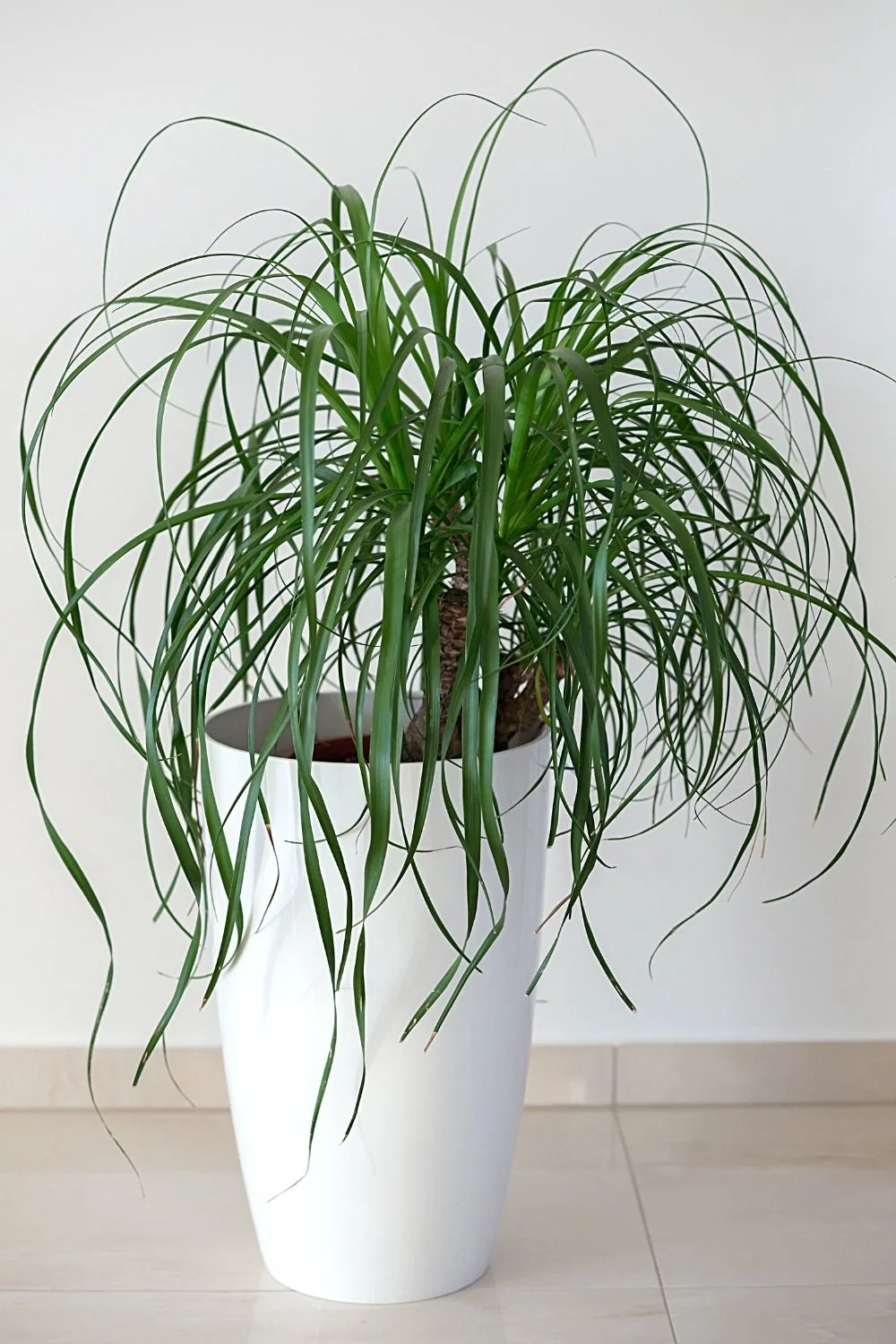
Since it’s easy to grow due to its low-maintenance requirements, you can easily make your Ponytail Palm thrive near a southwest-facing window
The Ponytail Palm is endemic to areas of Mexico, but it is currently grown as an aesthetic plant all over the world.
The Ponytail Palm has also been given by the Royal Horticultural Society the Medal of Garden Merit.
Regardless of its title and look, the ponytail palm is not a real palm. Rather, it is part of the family Asparagaceae.
Ponytail palms are unusual-looking, long-lasting indoor plants that flourish even if improper care is given. In fact, Ponytail palms are simple to care for so long as you avoid overwatering them.
- Scientific name: Beaucarnea Recurvata
- Size: 6 to 8 feet (1.8-2.4 meters) tall
- USDA Zones: Zones 9 through 12
- Growth rate: Slow grower
- Soil: Well-draining sandy
- pH: 5 to 7.5
- Water: Not more than once every two weeks
- Light: Full sun exposure
- Fertilizer: Cacti fertilizer in the spring season
- Temperature: 60 to 80 degrees Fahrenheit (15-26 degrees Celsius)
- Humidity: Average levels
8. Fiddle Leaf Fig
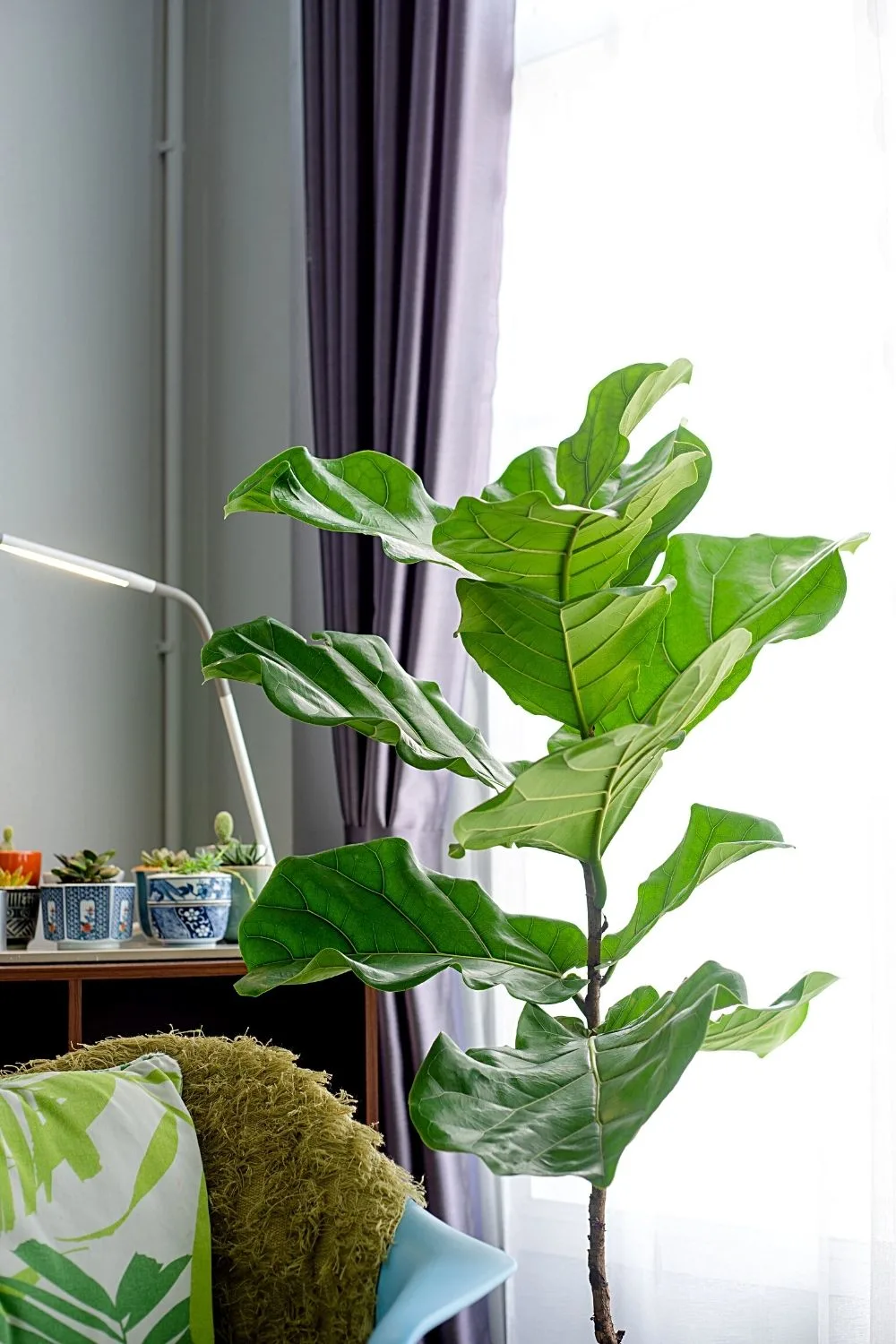
Despite its finicky growing needs, you can place Fiddle Leaf Fig near a southwest-facing window to make it thrive
Despite its notoriously finicky care needs, most houseplant enthusiasts like the Fiddle Leaf Fig.
This plant’s rich green, shiny foliage offers depth and flair to any living room when it grows, and it will look magnificent beside a southwest-facing window in the house or workplace.
- Scientific name: Ficus Lyrata
- Size: 6 to 10 feet (1.8-3 meters) tall
- USDA Zones: Zones 9 through 11
- Growth rate: Slow-growing
- Soil: Peat-based soil containing some perlite
- pH: 6 to 7
- Water: once every week or ten days
- Light: Direct afternoon and morning sun
- Fertilizer: A general-purpose fertilizer with an NPK ratio of 3-2-1
- Temperature: 65 to 75 degrees Fahrenheit (19-22 degrees Celsius)
- Humidity: 40 to 60 percent
9. Lavender Plant
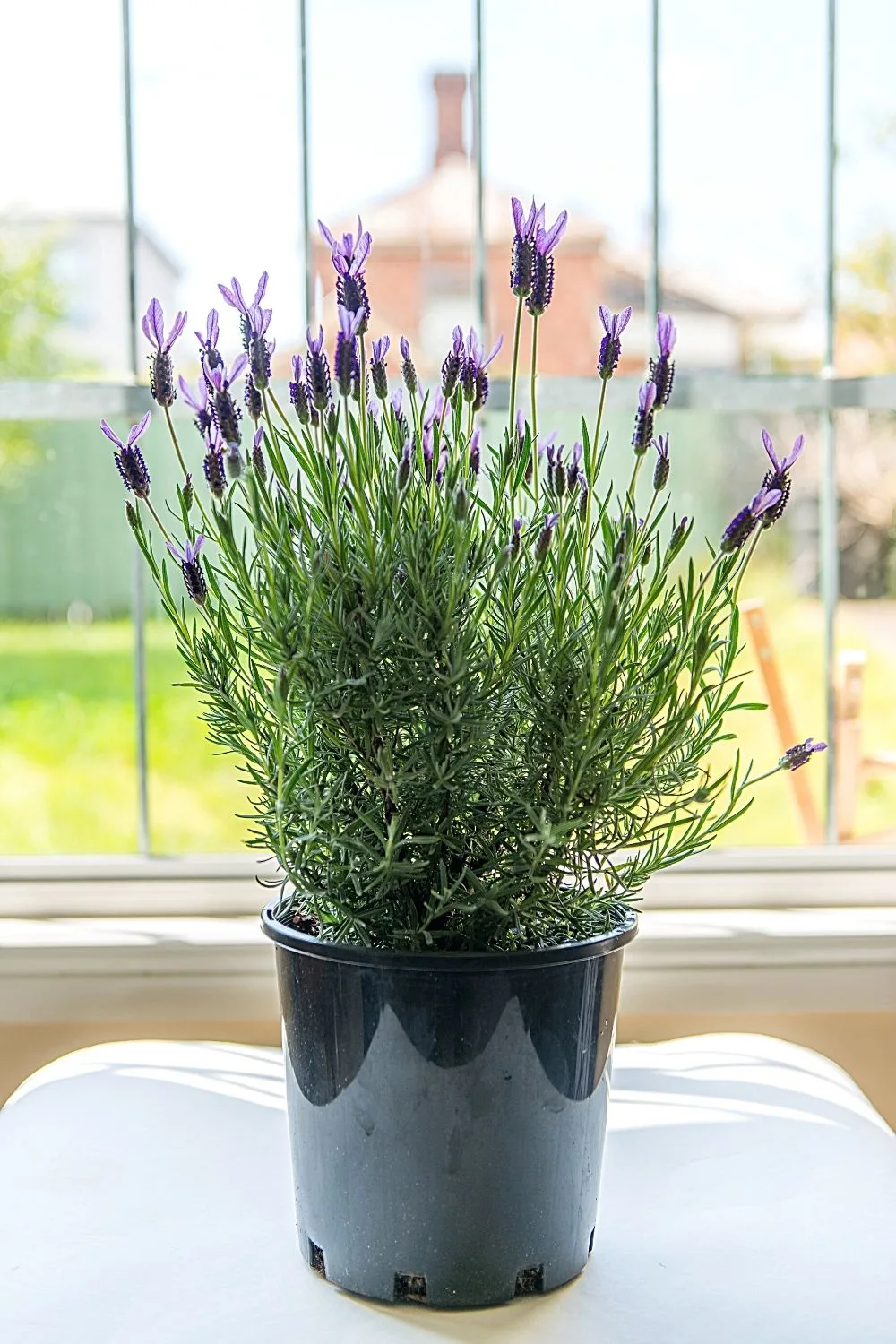
If you have a southwest-facing window in your room, you better place a Lavender Plant there to help you relax
The Lavender flower is a well-known blooming plant with a distinctive, relaxing scent.
This light purple plant is endemic to regions of Europe and is widely used in the production of vital oils, cosmetics, and foodstuffs.
It’s also a great interior plant because it’s easy to take care of and represents tranquility, elegance, and peace in the house.
- Scientific name: Lavandula
- Size: 6 to 2 feet (0.5-0.6 meters) tall
- USDA Zones: Zones 5 to 8
- Growth rate: Slow grower
- Soil: Slightly alkaline well-draining soil
- pH: 5 to 8
- Water: Once or twice after planting
- Light: 3-4 hours in direct sunlight
- Fertilizer: general-purpose or low nitrogen
- Temperature: 60-65 degrees Fahrenheit (15-18 degrees Celsius)
- Humidity: Low levels
10. String of Hearts

String of Hearts, b eing a forgiving plant when it comes to its care requirements, is a great plant to grace your southwest-facing window
The String of Hearts is a common perennial plant with tendrils that look like a rope of hearts.
In addition, this South African native received the Royal Horticultural Society’s Prize of Gardening Merit in 2017 for its look.
Although they may appear tough to care for at first, String of Hearts is among the most forgiving houseplants when you understand its growing requirements.
The houseplant also blooms while the stems produce tubers in the summer and spring seasons.
- Scientific name: Ceropegia
- Size: 7-1.9 inches (2 to 5 cm) tall
- USDA Zones: Zones 9 through 12
- Growth rate: In the right growing conditions, String of hears is a fast-growing plant
- Soil: Cacti potting mix that drains well
- pH: Neutral to acidic
- Water: Frequent watering while allowing it to dry out between every watering
- Light: Prefers bright indirect sunlight
- Fertilizer: Half-diluted, infrequent fertilizing
- Temperature: 80 to 85 degrees Fahrenheit (26-29 degrees Celsius)
- Humidity: 40 to 50 percent
11. Anthurium

Anthurium is another beautiful plant that can liven any living space in your home, including southwest-facing windows
Anthurium is a beautiful blooming plant from America.
It produces beautiful red, mauve, and white spathes with dark green spikes that leave a striking impression on your living room decor.
This plant complements places where you socialize with guests because it gives a very peaceful and friendly environment.
There are over 1000 varieties of this plant, all differing in shape, size, and color.
The plant is considered toxic, and hence it is advised to wear gloves when pruning or handling.
- Scientific name: Anthurium
- Size: 1 to 1.5 feet (0.3-0.4 meters) tall
- USDA Zones: Zones 10 through 12
- Growth rate: Slow to moderate growers
- Soil: Well-draining coarse potting mix
- pH: 5 to 6.5
- Water: Once every week
- Light: Medium to bright sunlight
- Fertilizer: Every 3-4 months with one-quarter strength fertilizer
- Temperature: 70 to 90 degrees Fahrenheit (21-32 degrees Celsius)
- Humidity: 50 percent or more
12. Areca Palm
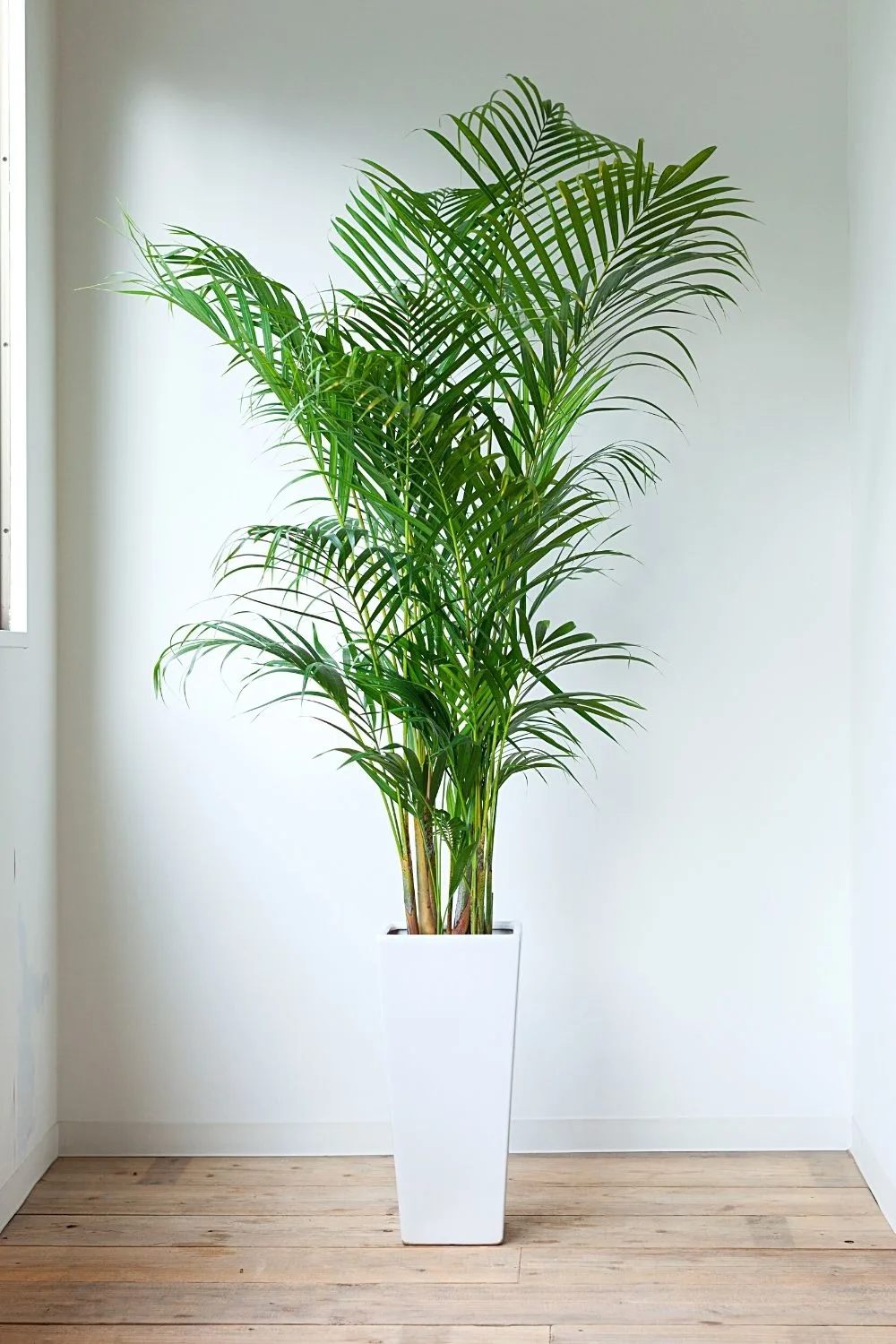
Also known as the Golden Cane Palm or Butterfly’s Palm, the Areca Palm is another great addition to grace your southwest-facing window
The Areca Palms are a Madagascar native that has spread throughout the world.
This variety is notable for its curled leaves and magnificent gold stalks and is sometimes recognized as the Butterfly’s Palm or Golden Cane Palm.
This plant was tested as part of NASA’s Clean Air Study, and it was found to eliminate xylene, formaldehyde, and toluene from the atmosphere.
- Scientific name: Dypsis Lutescens
- Size: 20 to 35 feet (6-10 meters) tall
- USDA Zones: Zones 10 through 11
- Growth rate: Fast-growing
- Soil: Soil that contains peat is porous and loose
- pH: 1 to 6.5
- Water: Once every week with distilled or rainwater
- Light: Indirect bright light
- Fertilizer: Slow-release fertilizer in the spring season
- Temperature: 65 to 75 degrees Fahrenheit (19-22 degrees Celsius)
- Humidity: Minimum of 40 percent
13. Bird of Paradise
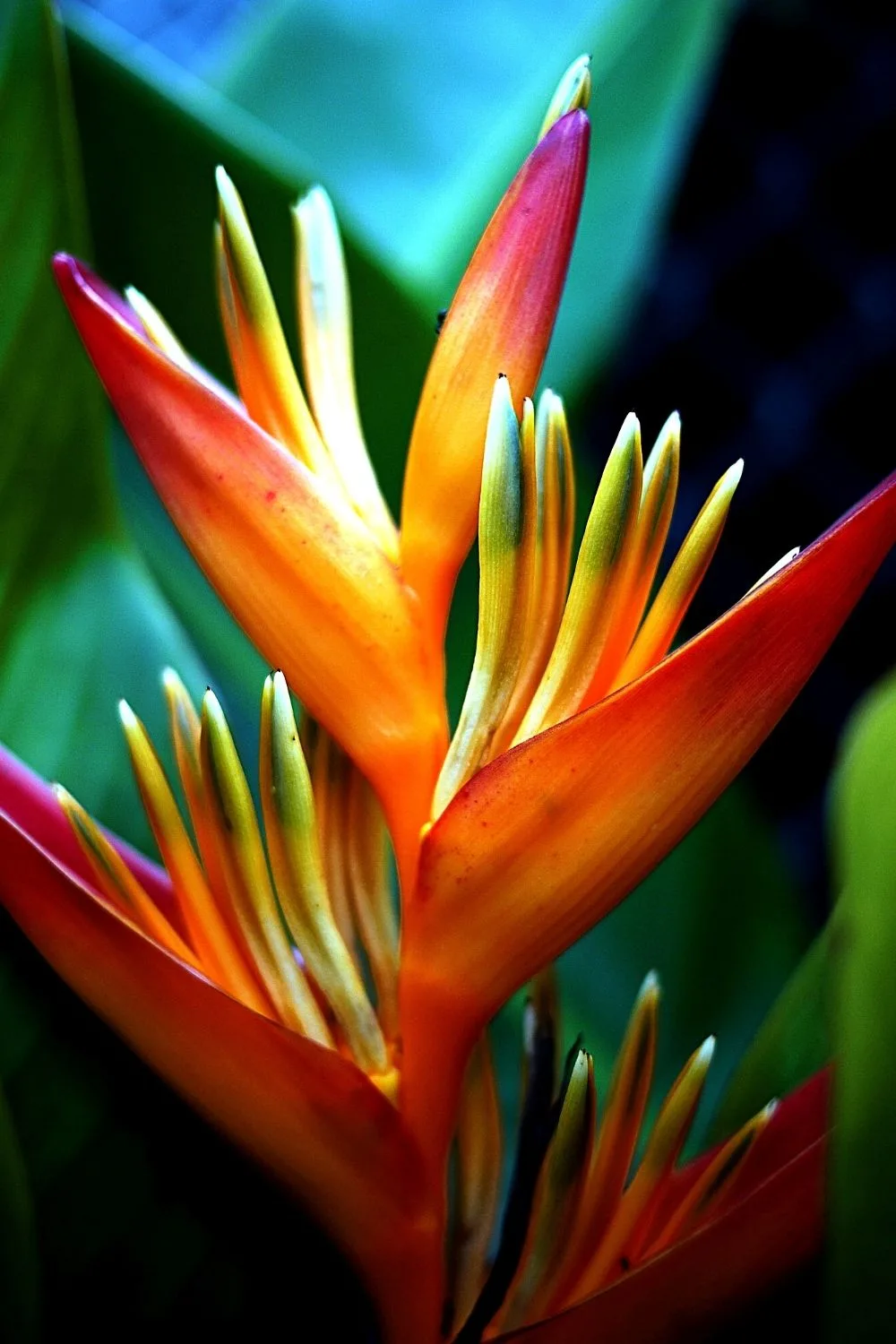
Bird of Paradise, with its beautiful blooms, is another great plant to grow near your southwest-facing window
The Bird of Paradise takes its title from its blooms, which are similar to the same-named bird variety.
This flower is an attractive tropical centerpiece for a bright area, symbolizing liberty, happiness, and heaven.
The divided foliage that gives the Bird of Paradise its bird-like appearance is thought to result from deliberate leaf ripping to minimize air drag.
- Scientific name: Strelitzia Reginae
- Size: 5 to 6 feet (1.0-1.8 meters) tall
- USDA Zones: Zones 9 through 11
- Growth rate: Moderate
- Soil: Well-draining, slightly acidic to neutral organic soil
- pH: 5 to 7.5
- Water: Let the top 2-3 inches dry between watering
- Light: Bright indirect or direct light
- Fertilizer: Manure, sewage sludge with an equal ratio of NPK
- Temperature: 65 to 70 degrees Fahrenheit (18-21 degrees Celsius)
- Humidity: Minimum of 50 percent
14. Dracaena Fragrans
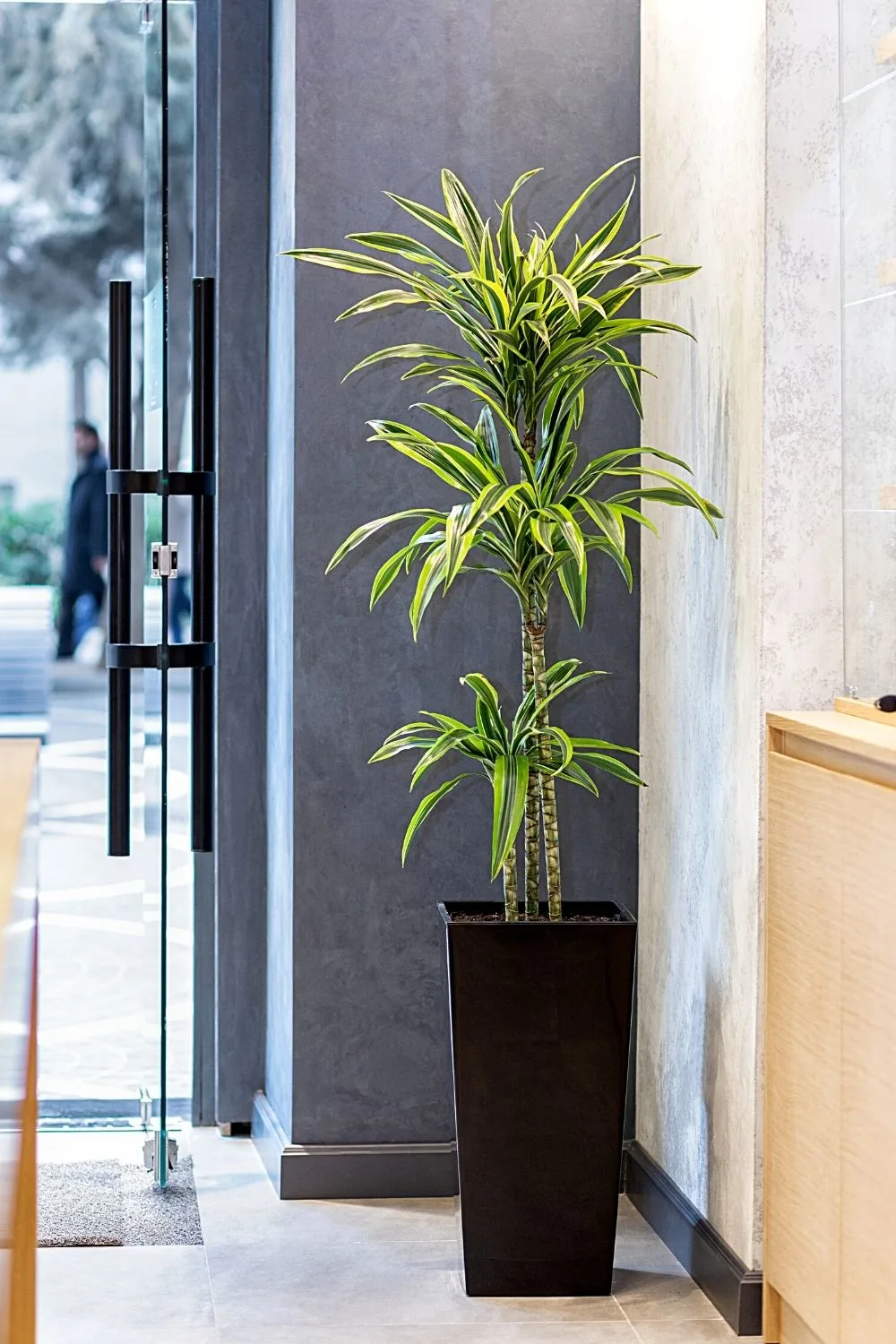
Dracaena Fragrans is a great plant to grow by your southwest-facing window if you love its ability to clean the surrounding air of toxins
Dracaena Fragrans is a blooming plant that grows in many parts of Africa.
It comes in a range of varieties, many with multicolored foliage, which is now the most famous among houseplant enthusiasts.
Dracaena Fragrans, often known as the corn plant, was a participant in NASA’s Clean Air Study.
The study shows that this type may eliminate dangerous compounds from the air, such as toluene, formaldehyde, and xylene.
- Scientific name: Dracaena Fragrans
- Size: 6 feet (1.8 meters) tall
- USDA Zones: Zones 10 through 12
- Growth rate: Slow grower
- Soil: Well-draining soil that contains peat and perlite
- pH: 6 to 6.5
- Water: Thorough watering and allowing its soil’s top 2 inches to dry first before watering the plant again
- Light: Indirect bright sunlight
- Fertilizer: Dilute houseplant fertilizer to half-strength
- Temperature: 60 to 75 degrees Fahrenheit (15-23 degrees Celsius)
- Humidity: Between 40 to 50 percent
15. Jade Plant
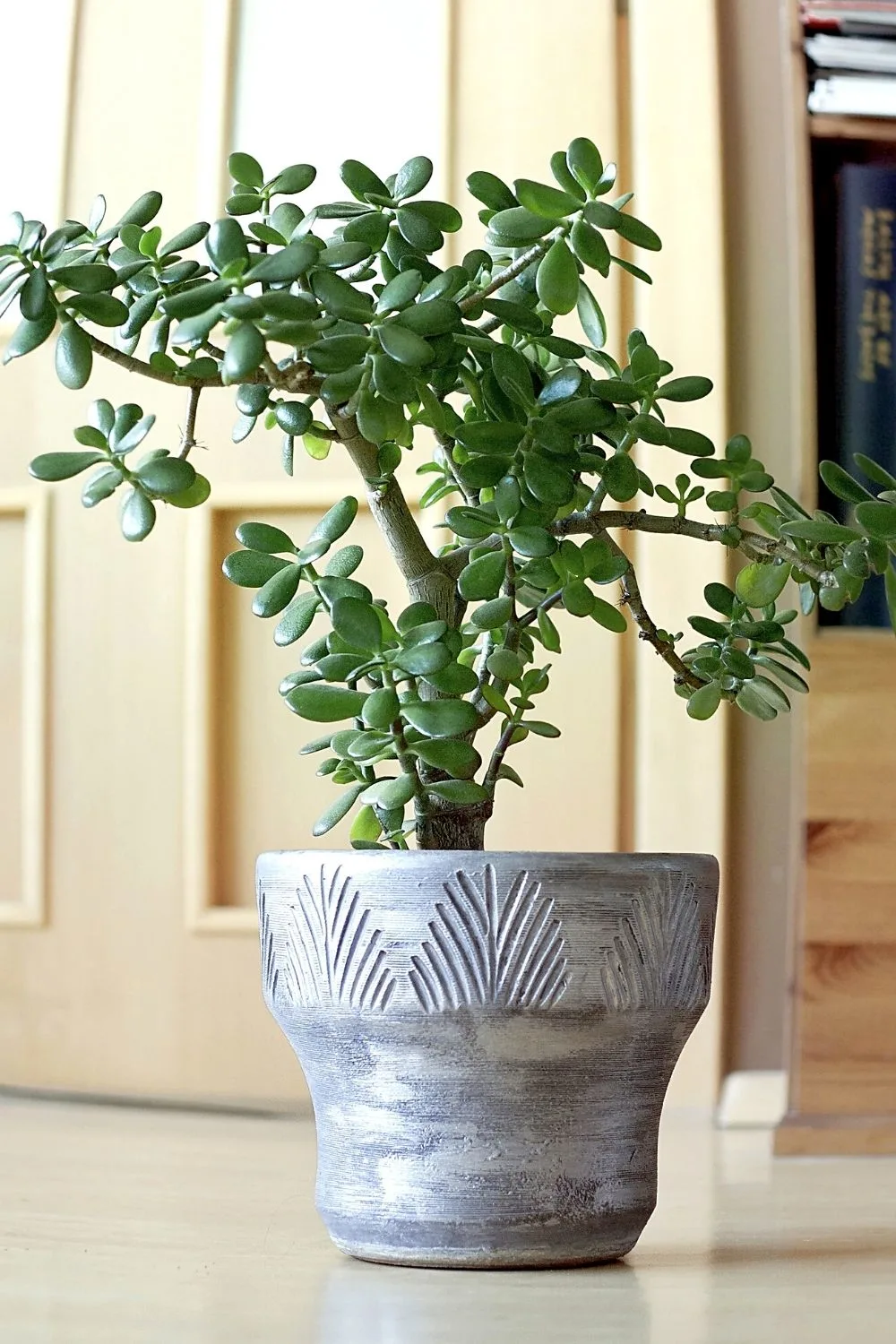
Jade Plant is a resilient and sun-loving plant that you can grow near your southwest-facing window
The Jade plant is a resilient, sun-loving variety native to South Africa. The plant has flat, shiny foliage with crimson margins that appear when exposed to a lot of sunlight.
Jade plants are typically simple to manage and are low-maintenance, but they’re prone to overwatering and several diseases.
Jade plants are great houseplants because they thrive in pots with limited root area.
It’s known to deliver success and good wealth to business owners, according to experienced feng shui professionals.
- Scientific name: Crassula Ovata
- Size: 3 to 6 feet (0.9-1.8 meters) tall
- USDA Zones: Zones 10 through 11
- Growth rate: Slow grower
- Soil: Well-draining and slightly acidic
- pH: around 6
- Water: Once every 2 to 3 weeks
- Light: 6 hours of bright sunlight
- Fertilizer: Watered-down liquid fertilizer
- Temperature: 65-75 degrees Fahrenheit (19-23 degrees Celsius)
- Humidity: 30 to 50 percent
Understanding Light and Temperature Requirements of Houseplants
Get to understand your southwest-facing window first before you start adding plants.
Here are some techniques that you can use to observe the light and temperature aspects:
- Observe the motion of sunlight in your home for a few days and see how it brightens the room.
- It’s a good idea to photograph the passage of bright sunlight with your phone, so you can return to it when selecting your plant purchases.
- Monitor the indoor temperature at various periods each day of the week. This vital piece of information will assist you in making appropriate plant choices.
- It will also assist you in designing a layout that fits most of your available rooms.
The Role of Light in Growing Plants
- Photosynthesis is a mechanism through which plants obtain the fuel they require to grow and flourish.
- Certain species, such as the Ponytail palm, Lavender plants, and Citrus trees, need extra light than others to complete this procedure. That’s why houseplants like these thrive when placed close to windows that face south.
- Since they developed and adjusted to specific light levels, certain plants require additional sun than the others. The species will show particular signs or die if these sunlight requirements are not satisfied.
- A plant’s leaves may become flat or seek a source of light if it gets insufficient sunshine.
- On the other hand, a plant’s leaves might brown all around margins or droop if it gets far too much sunshine. The severity with which these signs present varies on the type and its chosen lighting settings.
Bright Indirect vs. Direct Sunlight
Bright, Indirect Light
Based on the area, you’ll observe bright, filtered light roughly 5 feet beyond your southwest-facing window.
Sunlight that reflects off a barrier or other object before reaching your plants is bright, indirect sunlight.
During the day, southwest-facing windows provide lots of bright, indirect sunshine.
Bright, Direct Light
Bright, direct light can be found just next to, and usually within 3 feet of, a southwest-facing window.
The light that strikes your plants directly without reflecting off the other object is bright, direct sunlight.
This sunlight may be visible over several hours during the day if it originates out of a southwest-facing window.
What to Do to Protect the Plants in a Southwest Location from Extreme Sun Exposure
Note that although all plants require some level of light, too much can be harmful.
- The foliage can scorch, the soil may dry up, and the base can scorch if they are overexposed to strong sunlight and temperature.
- Try moving them to a north or east-facing window if you have delicate plants.
Fortunately, there are techniques to keep your houseplants safe from direct sunlight and heat.
Thin drapes or shades can soften sunlight from a south-facing window, or you can shift them away from the light.
When trying to optimize the lighting for your houseplants, you might want to try experimenting with these components.
Protecting the roots is also important as they too might get damaged because of extreme heat.
Double-potting the roots will safeguard them from harsh conditions.
During the day, objects besides a south-facing window will likely get extremely hot to touch. The pot in which your plants are planted may get excessively hot from the bottom as a result of this.
This can be mitigated by putting the pot in another ornamental container.
You also need to be very cautious about when you irrigate your plants that are placed in the southwest-facing window.
Irrigate in the mornings and evenings to keep a mild soil temperature during the day.
It’s ideal to water your plants early every morning so they have time to store the moisture and utilize it during hot hours of the day.
Conclusion About Plants for Southwest Facing Window
To conclude, even light-loving houseplants need protection from long hours of direct sunlight. The southwest-facing window is optimal for plants that strive for lots of bright direct light.
We’re hoping the tips shared here in this article helped (and will continue to help) you in preventing leaf scorching and sunburns.

Daniel has been a plant enthusiast for over 20 years. He owns hundreds of houseplants and prepares for the chili growing seasons yearly with great anticipation. His favorite plants are plant species in the Araceae family, such as Monstera, Philodendron, and Anthurium. He also loves gardening and is growing hot peppers, tomatoes, and many more vegetables.

